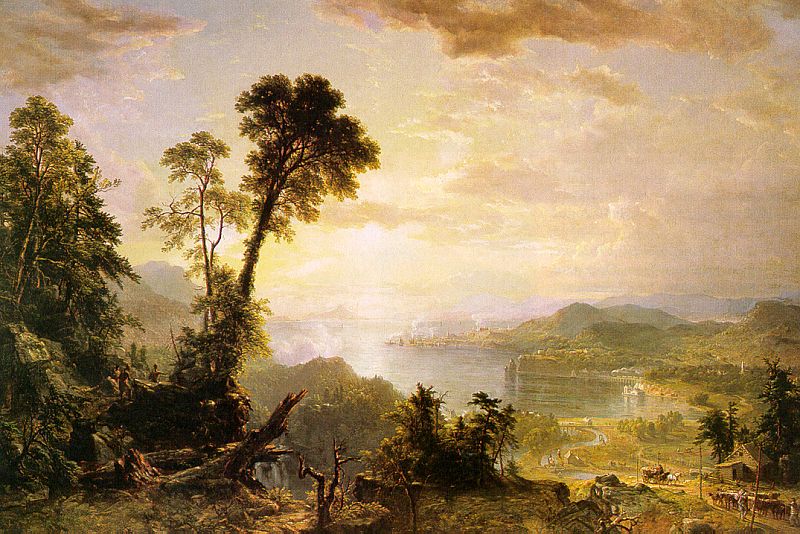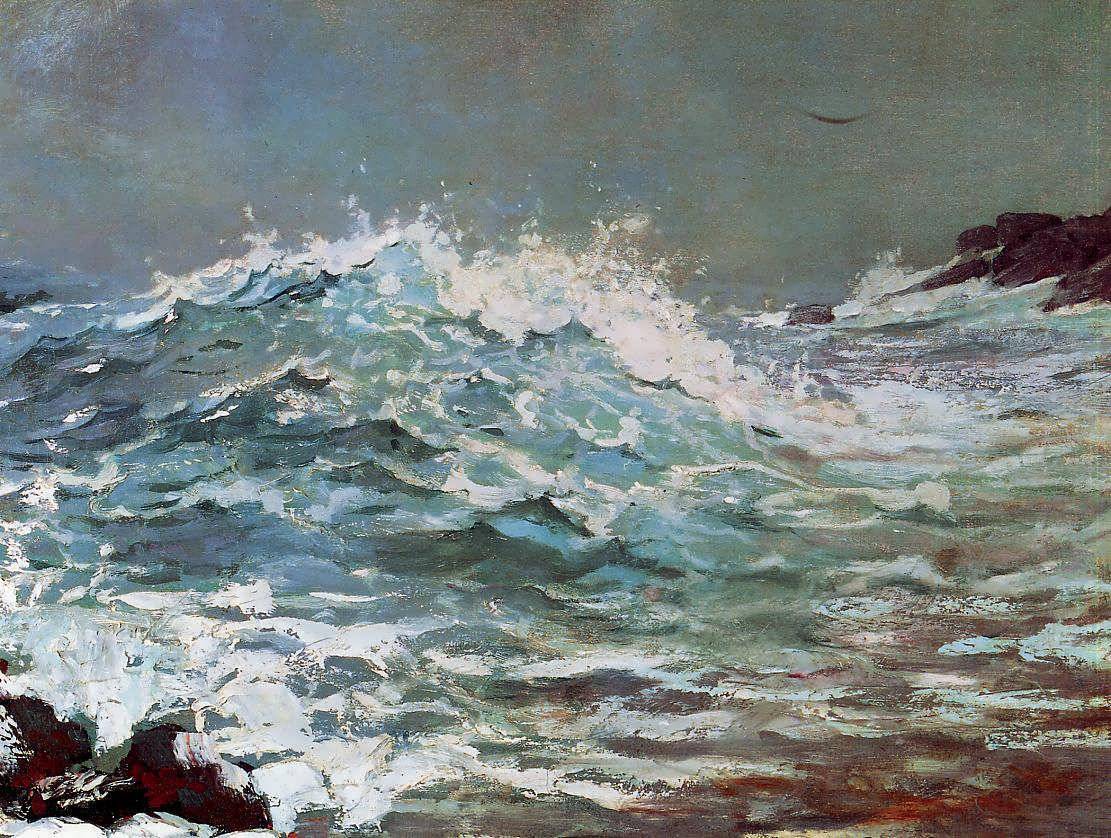New Britain Museum of American Art in Connecticut.
Frick Art & Historical Center, Pittsburg, PA. March 1-May 25, 2014
This exhibition features 50 paintings by American artists from the nation’s early years of independence through the dawn of the 20th century, and includes major artists and movements from the Peale family and Gilbert Stuart (1755–1828) to American Impressionists like Childe Hassam (1859–1935) and Theodore Robinson (1852–1896), with beautiful Hudson River School works falling in between.
The Warner Collection is one of the most significant collections of American art formed in recent decades, and the breadth and variety of works represented are both artistically and historically illuminating. The paintings included in the exhibition have been selected from the collection of American businessman and philanthropist Jonathan “Jack” Warner. Former CEO of Gulf States Paper Corporation and the founder of the Tuscaloosa Museum of Art, Mr. Warner has been a passionate collector of American art for more than 40 years.

Daniel Huntington
1816-1906
George Washington and Christopher Gist Crossing the Allegheny River
circa 1840
Oil on canvas
JWW0-0178
20″ x 24″
JWW
Organized according to a chronology that touches upon major themes, such as portraiture, still life, landscape, and genre painting, the exhibition showcases the dynamism and diversity of America's artistically and historically acclaimed painters. Included are major groups of works by Hudson River School painters and American Impressionists, as well as significant groups of work by individual artists such as Winslow Homer (1836–1910). Highlights include a watercolor on ivory miniature of Gilbert Stuart's most famous subject, George Washington, created by the Rhode Island artist in 1820, as well as several works by artists from the multi-talented Peale family. In addition to the paintings on view, An American Odyssey also includes a small selection of works on paper, including pastel, watercolor and extremely limited edition prints of drypoint etchings by the Pittsburgh artist Mary Cassatt (1844–1926).
The 19th century brought new possibilities for artists, in terms of both subject matter and format, as painters began to find inspiration in the vast and varied American landscape, which can be seen in masterworks by Thomas Cole (1801–1848), the famed founder of America's first true art movement, the Hudson River School. Exploring land as poignant metaphor for a growing country, Hudson River School artists used art as a vehicle for expressing a burgeoning sense of national pride, while also portraying nature's wildness and abundance. An American Odyssey features 18 canvases by influential Hudson River School figures, including groundbreaking paintings by Cole alongside works by Thomas Worthington Whittredge (1820–1910), Jasper Cropsey (1823–1900) and Albert Bierstadt (1830– 1902).
Albert Bierstadt
1830-1902
Colorado Waterfalls
Oil on Paper mounted on canvas
JWW0-0075JWF
19″ x 14″
Foundation
The exhibition also highlights Civil War-era artists, who explored genre subjects such as everyday life, introspection, nostalgia, community and society. Charcoal, watercolor and oil works created during the 1880s by legendary Boston artist Winslow Homer will provide viewers with a unique window into the development of a 20th-century American identity. During his prolific career, Homer documented the Civil War years and the increasing independence of women. As a freelance artist, he also created work for illustrated papers, including Harper’s Weekly, while his later work underscores an appreciation for the power of nature.
America's take on Impressionism is embodied in works by Childe Hassam (1859-1935), Theodore Robinson (1852-1896) and Maurice Prendergast (1858–1924). Exploring themes of travel, sophistication, cosmopolitanism and an avant-garde style, American Impressionists created works infused with vibrant sun-drenched colors, animated choppy brushstrokes, abstract compositions, and an expressive technique. Turning their brush to the physicality of painting and the individualistic eye of the artist, this group of forward-thinking painters paved the way for a new generation of 20th-century artists.
Book:
An American Odyssey is the story of Jonathan Westervelt Warner, entrepreneur, art collector, and philanthropist. The grandson of Herbert Westervelt, inventor of the EZ Opener brown-paper grocery bag and founder of Gulf States Paper Corporation in Tuscaloosa, Alabama, and the son of Mildred Westervelt Warner, former president of Gulf States and prominent American businesswomen, Jack Warner has kept alive his family's practices of business management and of good works and has also initiated a new tradition: since 1970 he has assembled an exceptional collection of American paintings, dating from the end of the eighteenth century to the end of the twentieth. Magnificent portrait, landscape, and history paintings from a roster of America's finest artists -- Albert Bierstadt, Mary Cassatt, William Merritt Chase, Frederic E. Church, Asher B. Durand, Thomas Cole, Sanford Gifford, Edward Hicks, Edward Hopper, Winslow Homer, William Sidney Mount, John Singer Sargent, and James McNeill Whistler -- tell a story not only of America but of American art. Likewise, this volume tells the story not only of an extraordinary collection of American art but of an equally extraordinary collector and his American odyssey.
From a review of the Philadelphia show (images added):
During the last year, Westervelt also sold a number of other masterpieces, most notably
Progress (The Advance of Civilization) by Asher B. Durand
and The Falls of Kaaterskill by Thomas Cole...
They offer a reasonably representative sample of 19th-century American painting, although one can only wish that the magnificent Progress, which reflects a quintessential Hudson River theme of civilization displacing wilderness, and Cole's Kaaterskill were in the mix.
Two of the more compelling pictures from that century are large still lifes of fruit by the German-born Severin Roesen.
Cole's Autumn Landscape from 1827-28
and Homer's evocation of roiling surf, The Backrush,
are also splendid, as are Alfred Jacob Miller's large oil of Indians racing at Fort Laramie
and a bucolic scene of an Indian encampment by a river by Thomas Worthington Whittredge.
Off in one corner,
a small landscape by Jasper Cropsey, Autumn on the River,
beautifully re-creates the interplay of muffled sunlight and placid water. One could easily slide by this gem; be sure not to. The show contains works by all the major Hudson River landscapists, but this Cropsey stands out.
The impressionist examples are less prepossessing, despite the presence of
a large, summery canvas by Childe Hassam of two women sitting on a porch.
Frederick Frieseke's woman with a green parasol more effectively delivers the quintessential impressionist blending of color, light, figure, and ground.
A large genre scene by Louis Lang, The Sewing Party,
introduces a lively domestic note. This intricately theatrical concoction is bracketed by a group of more homespun genre scenes by South Carolina native Edward Lamson Henry, one of several painters in the show known for images of Southern life.
A small picture by Thomas Hart Benton of black sharecroppers chopping cotton is tucked into another corner - like the Cropsey landscape, also easy to overlook. It complements several other pictures of Southern farm life by genre painter William Aiken Walker.
As for the father of our country, he's neatly circumscribed by Gilbert Stuart's fastidious miniature portrait, in watercolor on ivory,
and Andrew Wyeth's dry brush Washington at Valley Forge,
in which the general is all but invisible.









.jpg)


